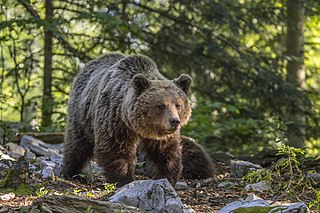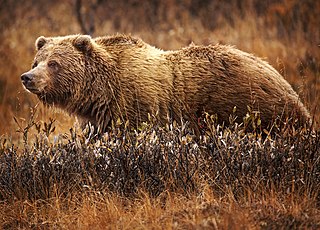
Bears are carnivoran mammals of the family Ursidae. They are classified as caniforms, or doglike carnivorans. Although only eight species of bears are extant, they are widespread, appearing in a wide variety of habitats throughout most of the Northern Hemisphere and partially in the Southern Hemisphere. Bears are found on the continents of North America, South America, and Eurasia. Common characteristics of modern bears include large bodies with stocky legs, long snouts, small rounded ears, shaggy hair, plantigrade paws with five nonretractile claws, and short tails.

The brown bear is a large bear species found across Eurasia and North America. In North America, the populations of brown bears are called grizzly bears, while the subspecies that inhabits the Kodiak Islands of Alaska is known as the Kodiak bear. It is one of the largest living terrestrial members of the order Carnivora, rivaled in size only by its closest relative, the polar bear, which is much less variable in size and slightly bigger on average. The brown bear's range includes parts of Russia, Central Asia, the Himalayas, China, Canada, the United States, Hokkaido, Scandinavia, Finland, the Balkans, the Picos de Europa and the Carpathian region, Iran, Anatolia, and the Caucasus. The brown bear is recognized as a national and state animal in several European countries.

The California grizzly bear is an extinct population of the brown bear, generally known as the grizzly bear. "Grizzly" could have meant "grizzled" – that is, with golden and grey tips of the hair – or "fear-inspiring". Nonetheless, after careful study, naturalist George Ord formally classified it in 1815 – not for its hair, but for its character – as Ursus horribilis. Genetically, North American brown bears are closely related; in size and coloring, the California grizzly bear was much like the Kodiak bear of the southern coast of Alaska. The grizzly became a symbol of the Bear Flag Republic, a moniker that was attached to the short-lived attempt by a group of U.S. settlers to break away from Mexico in 1846. Later, this rebel flag became the basis for the state flag of California, and then California was known as the "Bear State".

The sun bear is a species in the family Ursidae occurring in the tropical forests of Southeast Asia. It is the smallest bear species, standing nearly 70 cm (28 in) at the shoulder and weighing 25–65 kg (55–143 lb). It is stockily built, with large paws, strongly curved claws, small, rounded ears and a short snout. The fur is generally short and jet black, but can vary from grey to red. The sun bear gets its name from its characteristic orange to cream-coloured chest patch. Its unique morphology—inward-turned front feet, flattened chest, powerful forelimbs with large claws—suggests adaptations for climbing.

The Barbary lion, also called the North African lion, Atlas lion, and Egyptian lion, is an extinct population of the lion subspecies Panthera leo leo. It lived in the mountains and deserts of the Maghreb of North Africa from Morocco to Egypt. It was eradicated following the spread of firearms and bounties for shooting lions. A comprehensive review of hunting and sighting records revealed that small groups of lions may have survived in Algeria until the early 1960s, and in Morocco until the mid-1960s. Today, it is locally extinct in this region. Fossils of the Barbary lion dating to between 100,000 and 110,000 years were found in the cave of Bizmoune, near Essaouira.

The Eurasian brown bear is one of the most common subspecies of the brown bear, and is found in much of Eurasia. It is also called the European brown bear, common brown bear, common bear, and colloquially by many other names. The genetic diversity of present-day brown bears has been extensively studied over the years and appears to be geographically structured into five main clades based upon analysis of the mtDNA.

The Syrian brown bear is a relatively small and endangered subspecies of Eurasian brown bear native to the Middle East and West-Central Asia, particularly around the Caucasus Mountains.

The Himalayan brown bear, also known as the Himalayan red bear or isabelline bear, is a subspecies of the brown bear occurring in the western Himalayas. It is the largest mammal in the region, males reaching up to 2.2 m long, while females are a little smaller. It is omnivorous and hibernates in dens during the winter.

The Gobi bear, known in Mongolian as the Mazaalai (Мазаалай), is a subspecies of the brown bear that is found in the Gobi Desert of Mongolia. It is listed as critically endangered by the Mongolian Redbook of Endangered Species and by IUCN standards. Currently, there are only 31 bears left in the Mongolian Gobi Desert, which results are based on the long-term genetic monitoring and the population is relatively stable, however, the sex ratio is highly skewed towards to males. Gobi bears are separated by enough distance from other brown bear populations to achieve reproductive isolation. In 1959, hunting of the animal was prohibited in order to preserve the dying subspecies.

The Marsican brown bear, also known as the Apennine brown bear, and orso bruno marsicano in Italian, is a critically endangered population of the Eurasian brown bear, with a range restricted to the Parco Nazionale d'Abruzzo, Lazio e Molise, and the surrounding region in Italy. The Marsican brown bear differs slightly from other brown bears in its appearance and hibernation techniques. The bear's popular name is derived from Marsica, a historic area of the modern-day region of Abruzzo where the bear has long had a significant presence.

The Mexican grizzly bear is an extinct population of the grizzly bear in Mexico.

Bear hunting is the act of hunting bears. Bear have been hunted since prehistoric times for their meat and fur. In addition to being a source of food, in modern times they have been favored by big game hunters due to their size and ferocity. Bear hunting has a vast history throughout Europe and North America, and hunting practices have varied based on location and type of bear.

The Cantabrian brown bear, Iberian brown bear, or Iberian bear is a population of Eurasian brown bears living in the Cantabrian Mountains of Spain.

Ursus etruscus is an extinct species of bear, endemic to Europe, Asia and North Africa during the Pliocene through Pleistocene, living from ~5.3 million to 100,000 years ago.

The grizzly bear, also known as the North American brown bear or simply grizzly, is a population or subspecies of the brown bear inhabiting North America.
Ursus ingressus is an extinct species of the family Ursidae that lived in Central Europe during the Late Pleistocene. It is named after the Gamssulzen Cave in Austria, where the holotype of this species was found.
Formerly or currently considered subspecies or populations of brown bears have been listed as follows:

Brown bears were once native to Europe, much of Asia, the Atlas Mountains of Africa, and North America, but are now extirpated in some areas, and their populations have greatly decreased in other areas. There are approximately 200,000 brown bears left in the world. The largest population is in Russia, with 120,000 individuals. The brown bear occupies the largest range of habitats of any Ursus species with recorded observations in every temperate northern forest and at elevations as high as 5,000 m.

















